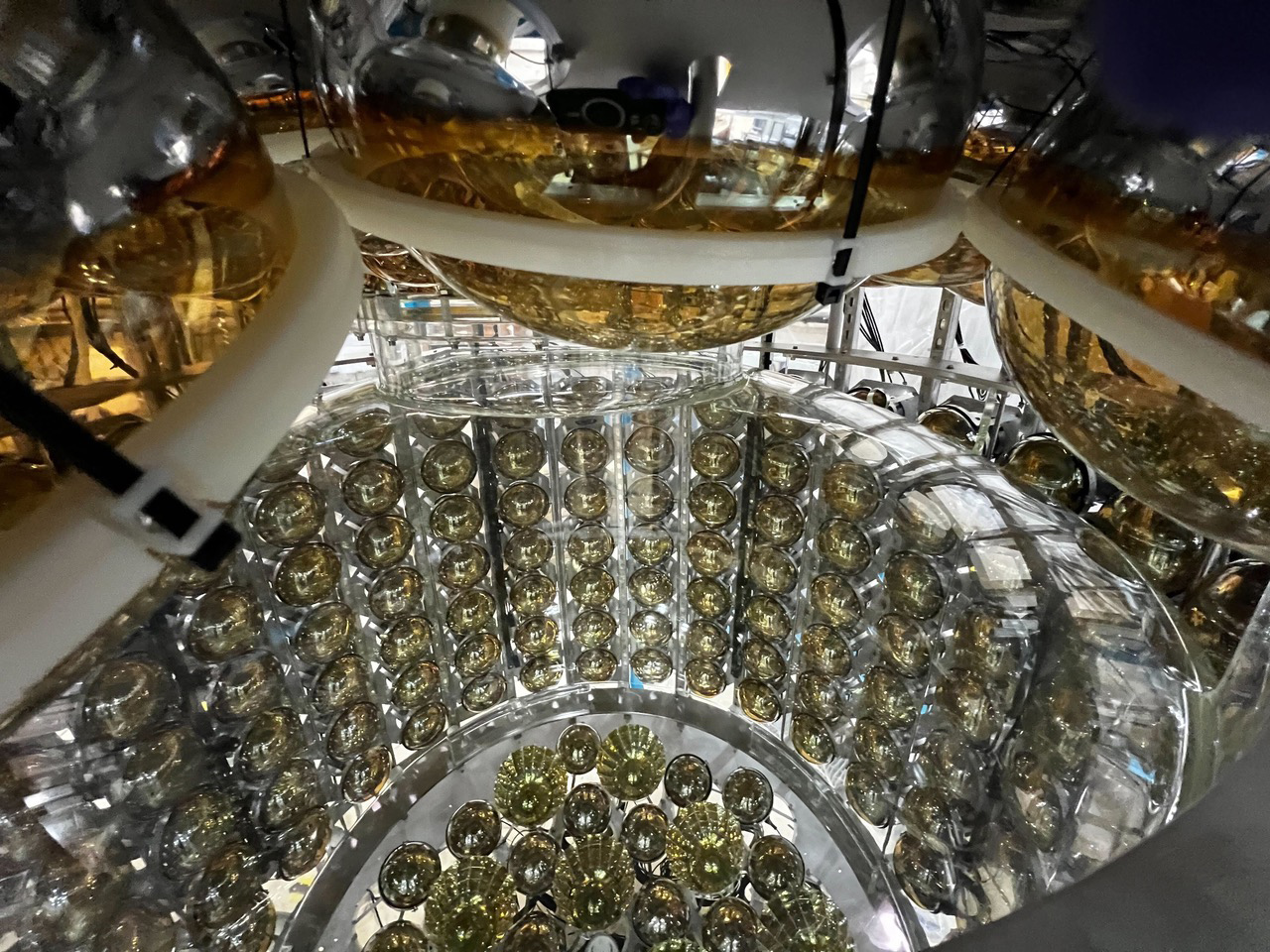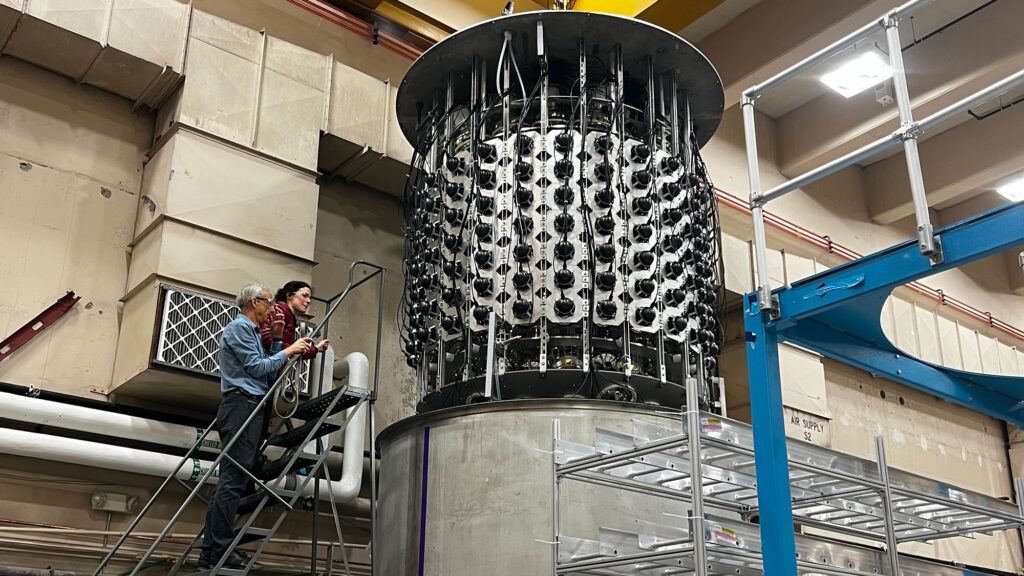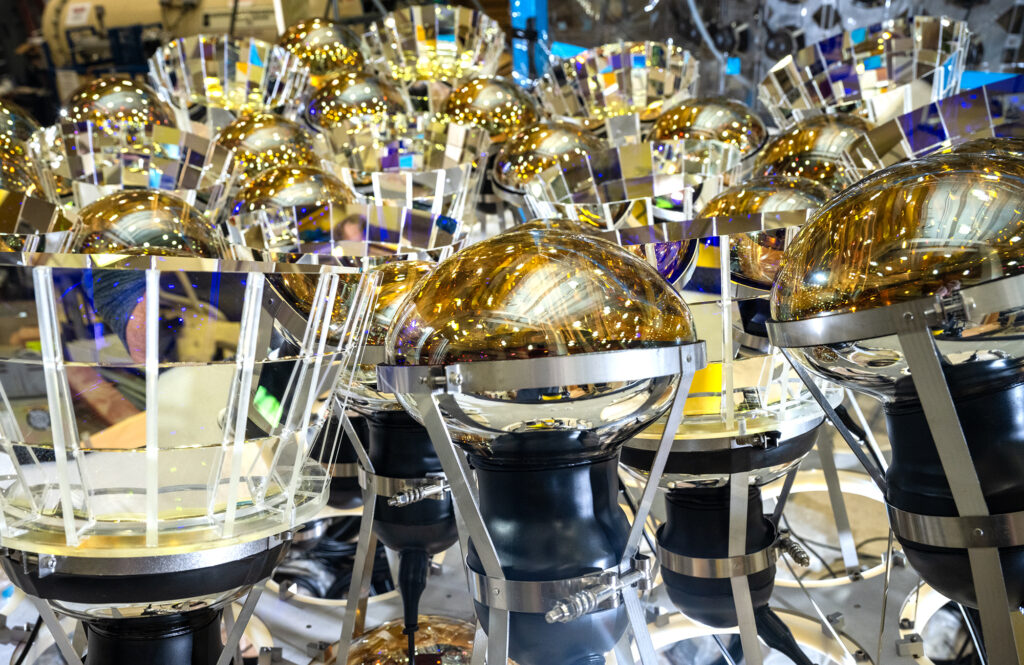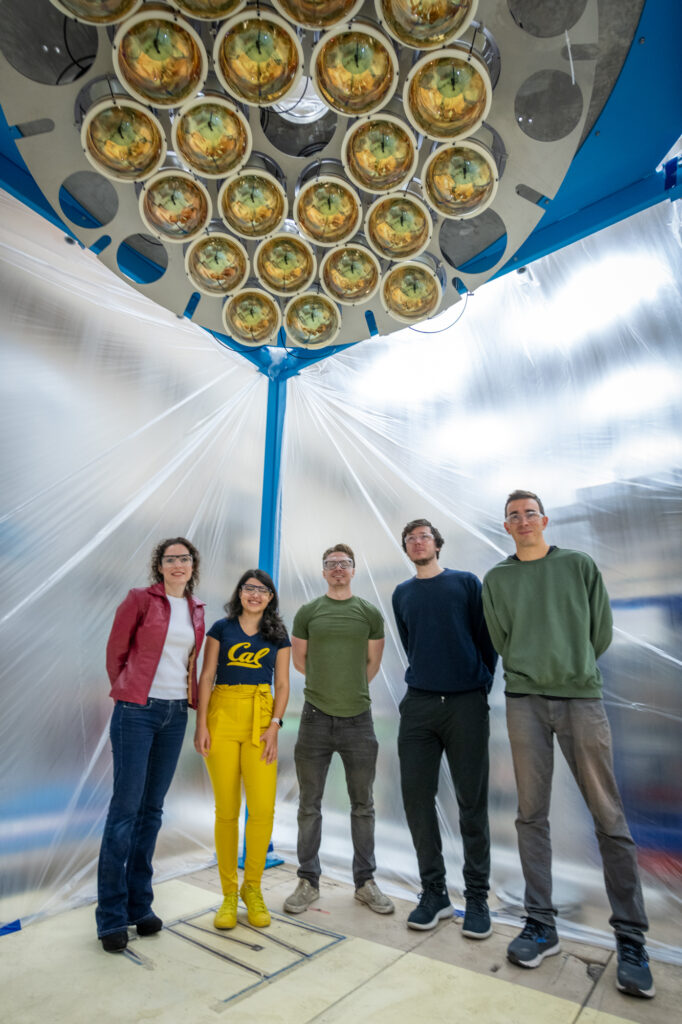Tests begin on sensitive neutrino detector for nonproliferation as well as physics
The four-ton Eos experiment, built at UC Berkeley, merges two types of neutrino detectors into one

Thor Swift/Berkeley Lab
March 15, 2024
Neutrinos and antineutrinos are nearly massless particles produced in many nuclear reactions, including the fission of uranium in nuclear power plants on Earth and the fusion reactions at the core of the sun.
But they are devilishly hard to detect — most pass through Earth without stopping — making it difficult to study the nuclear reactions taking place at the core of stars or in stellar explosions or to monitor nuclear power plants for illicit production of bomb material.
A new type of neutrino detector now being tested in a vast underground lab at the University of California, Berkeley, is designed to leverage the latest technologies to enhance the sensitivity and capabilities of antineutrino detectors. Such improved detectors would not only help detect, localize and characterize undeclared special nuclear material being used contrary to federal or international regulations, but also help scientists explore the fundamental physics of particles and their interactions deep in the nucleus of the atom.
Called Eos, for the Titan goddess of dawn, the apparatus signals “the dawn of a new era of neutrino detection technology,” according to Gabriel Orebi Gann, a UC Berkeley associate professor of physics, faculty scientist at Lawrence Berkeley National Laboratory (Berkeley Lab) and the leader of the Eos collaboration.
The prototype detector is funded by the National Nuclear Security Administration, which funds research and development at Department of Energy (DOE) labs to further the nation’s ability to detect, prevent, counter and respond to nuclear security threats — in the case of this research, to detect and characterize nuclear activities and materials remotely, that is, at distances greater than about 100 meters. While radioactivity from nuclear material can be shielded from detection, antineutrinos produced in fission reactions cannot. Because billions are produced in a reactor each nanosecond, Eos should be able to detect enough antineutrinos to identify clandestine production of bomb-grade material.
“The idea of neutrino detection is you can’t spoof it, you can’t shield it, you can’t fake it. Neutrinos travel at almost the speed of light, so they provide near-instantaneous detection, even at distance. They offer a unique signature of nuclear activity,” said Orebi Gann. “If you’re either a long way away or you’ve got a very weak signature, then you need a big detector. And for a big detector, you need liquid.”

Zara Bagdasarian/UC Berkeley
Eos is a 10-meter-tall, 5-meter-wide cylinder filled with water and an organic scintillator and surrounded by light detectors three times more sensitive than those used in physics experiments today. Eos’s improved sensitivity and higher resolution come from combining two of today’s best techniques for detecting neutrinos: scintillation and Cherenkov emission.
The improvements could be a game-changer for future neutrino physics projects, such as the Deep Underground Neutrino Experiment (DUNE) now being constructed in an abandoned gold mine in Lead, South Dakota, to detect neutrinos emitted by a particle accelerator at Fermi National Laboratory, 500 miles away in Illinois. UC Berkeley and Berkeley Lab are members of the DUNE collaboration.
“What we would ultimately like to build is a much bigger detector called Theia,” she said. “Theia is the Titan goddess of light and Eos’s mother in the pantheon of gods. The ideal location for Theia is in that mine in South Dakota, seeing those neutrinos from Fermilab.”
It remains to be seen whether Theia — which would employ a tank large enough to nearly swallow the Statue of Liberty — will replace one of DUNE’s four planned liquid argon “far” detectors. Orebi Gann argues that a hybrid detector like Theia, while providing comparable sensitivity for studying the high-energy beam of neutrinos that is the primary target of DUNE, would add new capabilities beyond an argon detector, including the ability to detect antineutrinos. Theia also would have a 2-degree pointing accuracy for the location of a supernova via the neutrino burst and would have the capacity to search for low-energy solar neutrinos and Majorana neutrinos.
A hybrid neutrino detector
Eos is unique in being a hybrid of the two main types of liquid neutrino detectors, both of which start with a tank of liquid.

Thor Swift/Berkeley Lab
One technique is based on a scintillator — in this case, linear alkylbenzene — that emits light in response to the charged particles produced during interactions with a neutrino or antineutrino.
Neutrinos and antineutrinos can also interact with other materials, such as water, to produce an electron, which then emits its own light, though much fainter than scintillation light. The latter is called Cherenkov radiation and is emitted when the electron plows through the liquid faster than the speed of light in the liquid, akin to the acoustic energy of a sonic boom produced by a plane traveling faster than the speed of sound.
In both techniques, sensitive light detectors called photomultiplier tubes are arrayed around the tank to record the intensity of the faint light. The intensity of the scintillation provides information about the energy of the neutrino or antineutrino. Cherenkov radiation, however, is emitted in a cone, so it can provide information on the direction from which the neutrino came, a critical piece of information for studying nuclear reactor sources as well as cosmic neutrino sources.
“Photomultiplier tubes are sensitive to single photon levels of light,” Orebi Gann said. “But a liquid scintillator gives you a lot more light: If you’ve got an electron at the same energy, you’ll get 50 times more light, depending on the scintillator, than from Cherenkov emission. That means you get better precision for understanding where the energy was deposited and how much energy there was.”
“We said, OK, we don’t want to pick and choose. We don’t like compromise. We want both. And that’s the goal here. We want the topology of Cherenkov light, but the resolution of scintillation,” she said.
The problem is that light from scintillation is so bright it overwhelms the Cherenkov light.
Luckily, Cherenkov light comes out in a picosecond burst, whereas scintillation light lingers for nanoseconds.
“If you have very fast photon detectors, you can use the time difference to help separate those two signatures,” she said. Eos will surround the liquid tank with 242 photomultiplier tubes made by the Japanese firm Hamamatsu that are three times faster than current photomultipliers.
The visible region of Cherenkov light has a redder color spectrum than scintillation light, which is mostly blue. The team takes advantage of this by surrounding the front row of photomultipliers with a “dichroic” filter that reflects red Cherenkov light into the photomultiplier but lets blue scintillation light pass through to photomultipliers in the back.
“You’re basically sorting your photons by wavelength and directing them to different photon detectors based on the wavelength,” she said.

Thor Swift/Berkeley Lab
Orebi Gann and her team began assembling Eos in September, delayed for six weeks by the destruction of the first steel tank when the truck carrying it collided with an overpass. The tanks are so large that the researchers had to house the experiment in a large basement lab — formerly occupied by a nuclear reactor — operated by UC Berkeley’s Department of Nuclear Engineering.
They surrounded the acrylic tank with the photomultiplier tubes, then lifted the whole assembly into a cylindrical steel tank. The internal acrylic tank and the gap between the acrylic and steel tanks were then filled with pure water, submerging the photomultiplier tubes in the gap. Once the team tests the ability of Eos to detect Cherenkov light from artificial radioactive sources and natural, cosmic muons, they will gradually add scintillator material to test the experiment’s ability to discriminate between the two types of light emissions.
“We have also designed our detector so we can deploy pure liquid scintillator,” Orebi Gann said. “This would be the ultimate test: if we can still see the Cherenkov signature even with the maximal scintillation component.”
Plans call for exploring how well Eos can monitor small modular reactors and nuclear-powered maritime vessels and check test site transparency.
Orebi Gann is eager also to employ the Eos design in general neutrino physics studies, such as measuring the flux of neutrinos from the core of the sun to verify the predicted nuclear reactions powering it; investigations of terrestrial sources of neutrinos; mapping the diffuse supernova neutrino background in the Milky Way and beyond; and the ongoing search for neutrinoless double beta decay, which would indicate that a neutrino is its own antiparticle.
All of these questions are already being explored with either the scintillator or Cherenkov detectors, but Orebi Gann is hoping that a hybrid detector will speed progress.
“The same kind of physics that each of those detectors has done in the past, we could do better,” she said. “That’s the goal. It’s R&D for the next generation.”